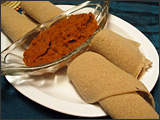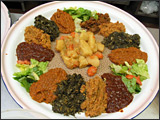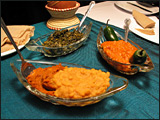After a short interval, an incredible thing happened. The two main dishes we ordered -- the Red Sea Combination and the Vegetarian Combination -- arrived on one large round platter that completely had the "oooh-aaah" factor going on. The plate was abundant, enticing, sexy, and aromatic. With less flexible diners, this might have been a mistake, say, for a strict vegetarian who didn’t want their vegetables touching any meat products. But for us, the party started as soon as we saw the platter. Artfully arranged sections of spicy lentils, peas, cabbage in tomato sauce, spinach, and chicken, lamb, and beef stews with a variety of hot or spicy/sweet toppings were presented to us on a platter lined with the tangy, spongy injera (Ethiopian unleavened bread). Each dish complemented the next: there were beef chunks seasoned with ginger and garlic, simmered with onions in butter; chicken Wot in spicy red pepper sauce; tender lamb; split peas cooked with turmeric; ground red lentils cooked with garlic and ginger; and my favorite, silssi, a spicy stew of tomatoes, jalapeños, and lots and lots of sweet onions reduced to a glistening deep red compote. Enough injera was brought on the side to enable my partner and me to tear off chunks and scoop each dish throughout the meal, no forks necessary. This art of gursha makes dining at Red Sea an engaging, intimate, hands-on experience like no other.
 Name: Sonya
Name: Sonya
Occupation: Information Systems Analyst
Location: Oakland
Favorite Restaurant: Ninna Restaurant
Reviewed Red Sea Restaurant: Tuesday, December 6, 2005
The Red Sea Restaurant and Bar is located on Claremont Avenue in Oakland right after it splits off of Telegraph, near the DMV. Parking is difficult on busy Claremont, but you can find space on the side streets. The restaurant bills itself as serving both Eritrean and Ethiopian food. We arrived early for dinner and the restaurant was empty. I heard talking and laughing coming from the bar, which is separate from the restaurant. They were speaking what I assume was Tigrigna or one of the other languages spoken in that region of East Africa. Upbeat, modern Eritrean/Ethiopian music from the bar spilled into the restaurant.
A lone waitress was sitting in the back of the restaurant. She smiled at us and came forward, telling us we could sit where we pleased. I opted not to sit near the door because I was cold. Our waitress was very personable. When I said that I was cold, she offered to turn on the heat. I said no, but throughout the meal, I wished that I hadn’t. I stayed cold.
Most of the tables in the restaurant seated four. Small, intimate pockets of space were created by the use of folding screens -- whether wrought iron, wood, or bamboo -- as well as moderate lighting. The décor featured pictures of Eritrean (or Ethiopian) people and a couple of woven baskets.
As I sat, reviewing the menu and looking around, I was reminded of some restaurants I’d visited in West Africa and I smiled. I liked the authentic flavor the place was sharing with its customers. The ambient music, the lilt of voices from the bar all contributed to making me feel transported.
We asked our waitress what she recommended, and she suggested that we try the Red Sea Combination and the Vegetarian Combination, so we did. I also ordered the vegetable sambusa (described as a type of fritter), the Timatim Fitfit salad, and honey wine. The waitress quickly returned and said they were out of the vegetable sambusa. I asked for the meat sambusa instead. A few minutes later, she came back and said they were out of that as well. The honey wine was like nectar. Sweet and sort of dessert wine-like, but much more refreshing. I definitely recommend it. Injera is the bread of life in Eritrean and Ethiopian cuisine. The Timatim Fitfit salad was a tasty take on a tomato bread salad: a large plate of injera pieces soaked in a spicy red sauce and mixed with a few diced tomatoes and onions. The entire dish had the flavor of lemon juice that was augmented by the naturally sour flavor of injera -- a spongy flatbread made from teff, a grain native to Eritrea and Ethiopia. The dishes were flavorful from the skillful use of berbere (a chili spice mixture) and tegelese tesmi (a garlic-ginger herb butter).
The two combinations were served family style, each entrée placed in small portions on a platter covered with injera. Two folded sheets of injera were served on the side. The Red Sea Combination provided samples of beef in a rich, spicy red sauce; lamb in a lighter spicy sauce; and chicken in a spicy red sauce. The Vegetarian Combination was tangy spinach, savory red lentils, mild yellow lentils, okra in a red sauce, and green salad tossed in a tart dressing. The sauce from each dish soaked into the injera, which we could have eaten if we hadn’t been so full.
As I mentioned, injera is ever present in an Eritrean/Ethiopian meal. The fermented flatbread has a distinct sour flavor that is an acquired taste. That flavor, in addition to the liberal use of lemon juice, permeates the meal with a definitive tang that can become tiring by the end of the meal.
We didn’t order dessert, nor did the waitress offer it. I remember that there seemed to be only two items on the menu, one being baklava. During our meal, a few patrons had come in, but the place was in no way full. Our meal seemed to go by quickly, and yet we had a long wait for the waitress to come and take our payment. She apologized for the long delay with a heartfelt smile.
All in all, I enjoyed the spicy cuisine at the Red Sea. I would recommend it to people who want to sample authentic Eritrean/Ethiopian cuisine.
 Name: Dave
Name: Dave
Occupation: Pharmacist
Location: San Francisco
Favorite Restaurant: Chapeau!
Reviewed Red Sea Restaurant: Sunday, December 4, 2005
Red Sea is an unpretentious Ethiopian restaurant and bar on the corner of Claremont and Telegraph Ave. in Oakland. When I arrived there at 7PM on a Sunday (12/4/05) evening, the bar side was hopping, but the restaurant side had only four or five people. I couldn’t find a hostess or server, so I stood by a man waiting for take out, thinking someone would show up eventually. A young woman eventually arrived and seated me. The restaurant is simply decorated: beige linoleum floor tiles, wooden tables with high-backed chairs, and Ethiopian folk art hanging on the walls. Knowing little about Ethiopian food I quizzed the server, who recommended the Vegetable Sambusa ($2) and the Red Sea Combination Plate ($9.75) with Meis (honey wine, $3 by the glass) as a beverage.
The Vegetable Sambusa is a thin, crisp, rectangular pastry crust (about the size of a Pop-Tart) filled with green peas and carrots seasoned with jalapeño. It arrived hot, and I loved the contrast of the sweet peas and carrots with the intense spiciness. Since most of the food served was fairly spicy, the cold, sweet honey wine was the perfect beverage.
The Red Sea Combination and my dinner companion's entrée (Zelbo: beef chunks braised with spinach and ginger, kicked up with lemon juice, $8.75) arrived served on the same large plate atop an enormous round of injera (a spongy, slightly sour Ethiopian flatbread) with more injera on the side for scooping up the food which, of course, you eat with your hands.
The Red Sea Combination consisted of five dishes. The chicken dish (Sebhi Dorho: whole chicken pieces in a rich, hot red pepper sauce with ginger, garlic, cardamom, and nutmeg) was flavorful and satisfying. A lamb stew (Begee Alitcha) was milder in spice, but the meat had lost some of its unique flavor from over-braising. The beef dish (Zigni) was served in a sauce similar to the chicken but had more of a paprika-like flavor. The two vegetable dishes were purées of chickpeas and ground red lentils and were somewhat bland. The slow-cooked, braised nature of this food makes it flavorful but dense and very filling, especially when combined with the flat bread it’s eaten with. My favorite dishes were my appetizer (Vegetable Sambusa) and the beef and spinach dish my friend ordered. I was too full to eat dessert (they offer only ice cream and baklava) and had plenty of leftovers to take home.



 Name: Wendy
Name: Wendy Name: Sonya
Name: Sonya Name: Dave
Name: Dave